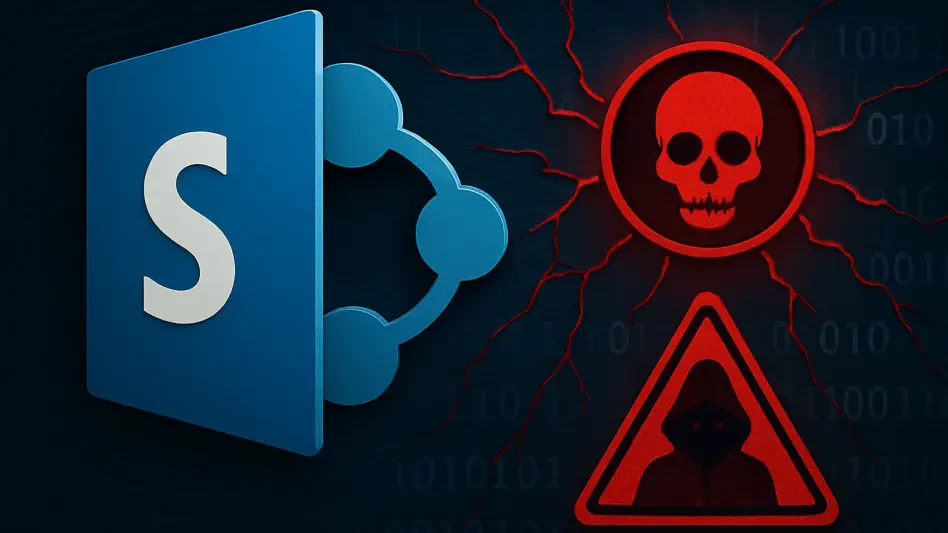In an era where cyber threats evolve at an alarming pace, a recent zero-day exploit campaign targeting Microsoft SharePoint Server has raised serious concerns among organizations relying on on-premise installations. This sophisticated attack, impacting approximately 400 entities worldwide, exploits unpatched vulnerabilities to infiltrate systems, deploy malware, and steal sensitive data with alarming stealth. Initially uncovered by cybersecurity experts, the campaign highlights a critical weakness in self-hosted servers, which often miss the automated updates that cloud-based solutions provide. With potential underreporting suggesting an even larger victim pool, the urgency to address these risks cannot be overstated. The implications stretch across diverse sectors, from government bodies to educational institutions, painting a stark picture of the challenges in securing legacy systems against modern threats. This discussion delves into the scope of the attacks, the technical intricacies involved, and the pressing need for robust defense strategies.
Understanding the Scope of the Threat
Global Impact Across Sectors
The scale of the zero-day exploit campaign targeting Microsoft SharePoint Server is staggering, with breaches reported across multiple continents and industries. Organizations in the United States bear a significant brunt, alongside notable incidents in regions like Mauritius, Jordan, South Africa, and the Netherlands. The diversity of affected entities—ranging from government agencies to multinational corporations and universities—underscores the universal nature of this threat. In South Africa alone, high-profile targets include a national treasury website, a major automotive manufacturer, and local government bodies. Despite swift isolation measures preventing operational disruptions in some cases, the breadth of impact reveals how deeply embedded Microsoft ecosystems are in critical infrastructure. The risk of sensitive data exposure, from financial records to intellectual property, looms large, emphasizing that no sector is immune to such pervasive cyber threats.
Regional Vulnerabilities and Responses
Focusing on specific regions, South Africa exemplifies the acute challenges faced by areas heavily reliant on on-premise SharePoint setups. The compromise of critical systems, such as those tied to infrastructure reporting and educational research, highlights the potential for widespread fallout, including supply chain disruptions and breaches of student data. Collaborative efforts with Microsoft and local incident response teams have been pivotal in mitigating immediate damage, yet the incidents expose a deeper issue of delayed patch management. Many organizations prioritize data sovereignty and custom security configurations over timely updates, inadvertently widening their exposure to exploits like remote code execution. This regional snapshot serves as a cautionary tale, illustrating how systemic reliance on legacy systems can amplify risks in the face of advanced persistent threats (APTs), necessitating a reevaluation of security priorities.
Technical Insights and Security Challenges
Anatomy of the Exploit Chain
Diving into the mechanics of this zero-day campaign reveals a highly complex exploit chain designed to bypass SharePoint’s authentication controls through its web interfaces. Attackers deploy custom payloads that enable lateral movement across internal networks, exploiting collaborative features like document libraries to spread malware. The use of fileless execution techniques, which operate in memory to evade traditional antivirus tools, marks a significant evolution in threat tactics. Additionally, obfuscated PowerShell scripts and living-off-the-land binaries (LOLBins) ensure persistence, while anti-forensic measures mask command-and-control communications with external servers. This level of sophistication not only challenges conventional defenses but also signals a shift toward more elusive and damaging cyber operations, pushing organizations to rethink how they safeguard their digital environments against such intricate attacks.
Limitations of On-Premise Security
On-premise SharePoint deployments, while offering control over data and customization, often fall short in security compared to cloud-hosted alternatives managed through platforms like Microsoft Azure. The absence of automated patching leaves these systems vulnerable to exploits like privilege escalation and remote code execution, as seen in the current campaign. Microsoft has stressed that only on-premise servers are affected, urging immediate application of security updates and network segmentation to limit exposure. However, many organizations struggle with the resources or expertise to implement such measures promptly. Cybersecurity experts advocate for adopting zero-trust architectures and continuous vulnerability scanning, arguing that reliance on outdated security postures exacerbates risks. This gap between control and protection remains a critical hurdle, especially as attackers exploit these weaknesses with increasing precision.
Strategies for a Safer Future
Immediate Actions for Mitigation
Reflecting on the zero-day exploit campaign that targeted Microsoft SharePoint Server, immediate steps taken by affected organizations provided crucial lessons in rapid response. Swift system isolation and collaboration with Microsoft for remediation helped avert operational crises in several instances, particularly in high-profile cases like South Africa’s national treasury breach. Applying security patches without delay proved essential, as did network segmentation to contain lateral movement of malware. These actions, while reactive, underscored the importance of having predefined incident response protocols in place. For entities still managing on-premise systems, prioritizing these basic yet effective measures became a cornerstone of minimizing damage. The urgency of such responses highlighted how preparedness could mean the difference between containment and catastrophic data loss in the face of evolving cyber threats.
Long-Term Defense Innovations
Looking beyond immediate fixes, the campaign prompted a broader push toward modern cybersecurity frameworks that could prevent future breaches. Adoption of zero-trust architectures emerged as a key recommendation, ensuring that no entity or user is inherently trusted, even within internal networks. Continuous vulnerability scanning and threat hunting also gained traction as proactive ways to identify and neutralize risks before exploitation. For regions like Africa, where Microsoft ecosystems underpin much of enterprise content management, investing in these advanced defenses became imperative to protect critical infrastructure. The balance between maintaining data sovereignty and embracing cloud-like security features sparked ongoing debates, yet the consensus leaned toward hybrid models that combine control with robust protection. These forward-thinking strategies aimed to fortify on-premise environments against the sophisticated APTs that had already exposed significant vulnerabilities.








